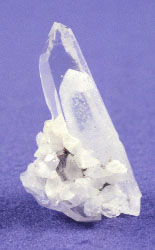Congratulations to the following 2006 Evolving Earth Student Grant recipients:
Boyer, Doug
Stony Brook University, Department of Anatomical Sciences
Research Web site
“Dietary Analysis of Stem-Primates: Implications for Adaptive Origins of Euprimates.”
This project proposes to image fossil teeth of extinct euprimates and those of the closest relatives of euprimates (plesiadapiformes) using laser scanning technology. Features that reflect dietary preferences will be measured on these scans. These data will test the hypothesis that there was an ecological shift to greater faunivory in the evolutionary transition from stem-primates to the ancestor of euprimates.
Cabbage, Patrick
Washington State University, Department of Geology
“Constraining the source(s) of floodwaters that formed the northern Channeled Scabland, eastern Washington”
This project will integrate detrital zircon geochronology, Sm-Nd geochronology, and sedimentologic evidences within a detailed stratigraphic framework to constrain whether floodwaters that formed the northern Channeled Scabland were sourced from beneath the Cordilleran Ice Sheet to the north. Constraining the source(s) of the floodwaters which formed the Channeled Scabland may provide a better understanding of Cordilleran Ice Sheet dynamics, as well as provide a better understanding of the Recent geologic history of eastern-central Washington.
Callahan, Owen
Western Washington University
“Exhumation and topographic development of the Okanogan Range, northeast North Cascades”
The goal of this project is to resolve the mid to late Cenozoic topographic evolution of the Okanogan Range, which defines the northeast border of the North Cascades. While the Okanogan Range lies between regions with inferred late Miocene surface uplift, paleobotanical evidence from the Okanogan region suggests high elevations have existed since the Eocene. I will use low-temperature thermochronology, Eocene surface reconstruction, and computer modeling to better constrain the paleoelevation of the region.
Cleaveland, Laura
Brown University
“New applications of alkenone paleothermometry to marine sections exposed on land and implications for Mediterranean Sea surface temperature reconstruction”
I propose to investigate the validity of alkenone-derived sea surface temperature (SST) records obtained from marine sedimentary sections that have been uplifted and exposed on land. The alkenone proxy is widely used to generate records of past SST from deep sea sediment cores obtained through ocean drilling operations. If we can show that alkenone paleothermometry can also be applied to sections of rock exposed above sea level, many avenues for future study will open up. Specifically, we hope to apply this technique to marine sedimentary sections exposed in the Mediterranean region in order to reconstruct the temperature history of the Mediterranean Sea over the Miocene-Pliocene cooling that ultimately led to northern hemisphere glaciation.
Friedman, Matt
The University of Chicago
“The forgotten diversification event: ecological and faunal perspectives on the evolutionary radiation of the acanthomorph teleosts”
Acanthomorpha is a diverse and morphologically heterogeneous radiation of teleost fishes that offers a unique system for studying changing patterns of function and ecology over time. An integrative approach combining mathematical models of character evolution morphological and molecular phylogenies, computer simulations, geometric morphometrics, and recent macroecological findings will be used to examine; (1) the role of mass extinctions in shaping subsequent diversification events; (2) the evolutionary significance of changing levels of morphological diversity over time; (3) the role of geography in the origin of morphological variety by determining the relative contribution of between-and within-fauna diversification.
Jackson, Frances
Montana State University, Department of Earth Sciences
“A Study of Egg Porosity and Incubation Environment in Extinct Taxa”
Data on nesting biology of extinct taxa are rarely considered in evolutionary hypotheses regarding the origin of avian reproductive behaviors. Egg gas conductance values calculated from this study will provide baseline data on incubation environment.
Lambert, Joe
The University of Alabama
“Paleoclimate and Shifts in Storm Intensities/Frequencies During the Late Holocene for the Gulf Coast, U.S.A”
There are two major research objectives for the proposed study. A record of pre-historic hurricane impacts is hypothesized to be preserved in stalagmites in DeSoto Caverns, Alabama by means of stable oxygen isotope signatures. Recent improvements in sampling resolution may allow for individual storm events to be identified in a 3000-year old stalagmite. Stalagmite proxy records have long been accepted as tools for interpreting past climate conditions (precipitation, temperature). Understanding past climate and storm activity for the Gulf Coast will aid in making predictions of future climate variability.
Nesbitt, Sterling
Lamont-Doherty Earth Observatory of Columbia University
“The early history of the archosaurs: The search for the common relatives of crocodylians and birds.”
Birds and crocodylians (archosaurs) are each others closet living relatives and share a common ancestor in the early portion of Triassic (240 mya). However, we know little about the early history of the archosaurs; what they looked like, where they lived, what they ate, how they moved. Triassic rocks of Tanzania is one of the only places that preserves early archosaurs. These archosaurs will help us understand evolution of features that later are important to both crocodylians and birds.
O’Leary, Elizabeth
Florida Museum of Natural History
“Anemochory Inventory: Investigating fossil and modern winged fruits.”
Collecting winged fruits in the field and photographing winged fruits at paleobotanical collections to create an image based database.
Rose, Kathryn
Department of Geology, University of California, Davis
“Investigating Deglacial Climate Records: The Carbon Isotope Minimum Event and High-Resolution Radiocarbon Ages”
One pervasive characteristic of glacial terminations over the last 400,000 years is reorganizations in the ocean-atmosphere system. Associated with these reorganizations are perturbations in the carbon isotope record (13C, the ratio of 13C to 12C) in fossil foraminifera, used to trace changes in deep ocean circulation. A characteristic feature of the early deglacial record is an abrupt decrease in 13C of seawater as recorded by fossil foraminifera. However, conclusive evidence for the mechanisms of this event remains elusive. My research focuses on understanding the mechanisms responsible for the CIME and associated oscillations in the climate system.
Witmer, John
Bucknell University
“Analysis of a previously unexplored marine section spanning the Triassic-Jurassic boundary in Wrangell-St. Elias National Park, Alaska: Implications for paleogeographic and paleoclimate conditions during a global mass extinction event.”
This study proposes the first high-resolution stratigraphic analysis of the Triassic-Jurassic McCarthy Formation in the Wrangell Mountains, Alaska. Lithostratigraphic and biostratigraphic data from two measured sections along with stable isotopic analyses will permit reconstruction of the paleogeography and paleoclimate within Wrangellia and permit evaluation of causal mechanisms of biodiversity loss during the Triassic-Jurassic mass extinction event.

